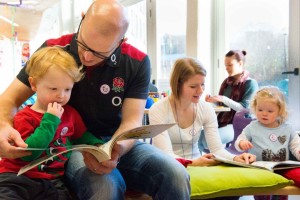| Seven Stories – The National Centre for Children’s Books Anthony Pavlik |
Download PDF |
The chatter of excited young children and serious academic scholarship are two things one would not normally associate with each other. Seven Stories, The National Centre for Children’s Books, manages to straddle those seeming contradictions. Established in 2005, and refurbished in 2015, Seven Stories is part of an urban regeneration project that took an old Victorian waterside mill and transformed it into the national home for UK children’s literature from the 1930s to the present day, with a mission to save, celebrate and, more importantly, share what is a rich literary tradition of writing and illustrating books for children in the UK.
Image 1: ©Seven Stories, The National Centre for Children’s Books. Photography by Damien Wootten [End of Page 59]
For scholars, Seven Stories maintains a constantly growing archive of all that goes into the making of a children’s book – including things like draft manuscripts, author emendations, relevant correspondence – with more than two hundred British writers and illustrators represented in the collection. Contributions include material from authors such as Enid Blyton, Philip Pullman and David Almond, Judith Kerr and, most recently, Michael Morpurgo’s entire archive collection. The nearby museum, also part of the Seven Stories project, houses the collection of British children’s literature illustrations.
My own first trip to Seven Stories was during my doctoral studies at Newcastle University (with which Seven Stories is closely associated, offering joint PhDs) and, on subsequent visits, I recall learning how to handle archive materials, with white-gloved hands. The growing archive, of which the content catalogue can be accessed online through the Seven Stories website, allows scholars to investigate the way beloved novels developed, providing an insight into the creative writing process itself. But Seven Stories is not just for the academic community.
Each year, 80,000 visitors take the opportunity to explore Seven Stories’ seven floors of workshop-, performance and creative spaces. Activities for young children include dressing-up and drama, creative writing and wordplay, illustration and crafts, and there are regular and varied exhibitions, which have recently included presentations on the work of Michael Foreman, the illustrations for the Harry Potter books, and a Nursery Rhyme Exhibition. Many children’s authors and illustrators also offer talks and workshops at Seven Stories, giving visitors, whether scholar or not, the chance to speak to children’s writers directly. Having heard David Almond speak about his writing process, I can attest to the value of such opportunities.
Seven Stories is not, however, just for those who take the time to travel to Newcastle. As a national centre, Seven Stories regularly takes its exhibitions on tour around the UK. Touring exhibitions in 2016 include ‘A Viking’s Guide to Deadly Dragons with Cressida Cowell’ and ‘Mystery, Magic and Midnight Feasts, the Many Adventures of Enid Blyton’. [End of Page 60]
Image 2: ©Seven Stories, The National Centre for Children’s Books. Photography by Damien Wootten
With its own café and a large bookshop dedicated to children’s books, Seven Stories is a resource for all, promoting an understanding of, and pleasure in, books for children in all their different forms, and a visit means the opportunity to rub shoulders with those who really know about children’s books: young readers themselves. In that, Seven Stories is a mixing of minds – and adult academics sharing space with happy children, excited by books and story and illustration, is a good reminder of who the intended audience really is for the texts we, as adult critics, pore and pick over.
http://www.sevenstories.org.uk/
Anthony Pavlik (PhD) currently teaches in the English Department at the University of Münster. His main interests are the use of children’s literature and drama in EFL. He has published on a wide range of topics in children’s literature. [End of Page 61]



